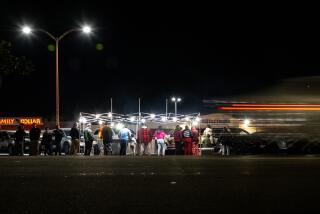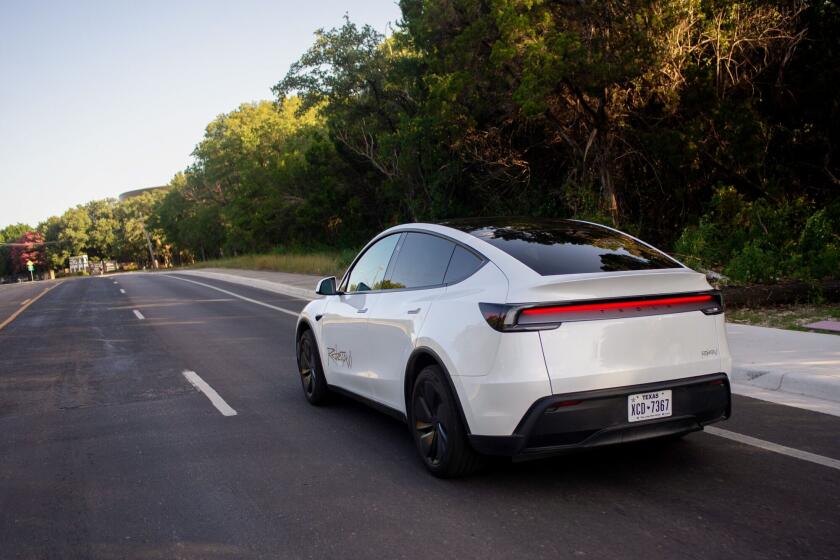Ice Cream Trucks Becoming a Hot Safety Issue
- Share via
Michael Holloway remembers when as a kid he used to chase after the ice cream trucks in his Inglewood neighborhood, clutching a handful of coins. Today, Holloway is 27 and he’s the one being chased.
In his first day on the job as an ice cream truck driver earlier this month, Holloway parked outside Woodworth Elementary School in Inglewood--the same school he once attended--and waited for the children to come streaming out.
The weather was hot, and Holloway soon had a line of pint-sized customers inquiring about his ice cream and candy treats.
One girl in pigtails asked to examine the Starbursts, Butterfingers and Ghostbusters chewy candies. None of them were just right. After finally settling on two 50-cent candy pops, the girl left the truck, strolled down the street, spun around, came back and said, “Can I have my dollar back?”
“Sure,” Holloway said, giving her the refund and accepting back the pops. “Come again.”
Indecisive youngsters are one of the minor problems facing ice cream truck operators.
A big one is the increasing number of traffic accidents involving their young customers.
Area legislators are considering bans or restrictions on ice cream trucks, and the trucks’ electronic bells, that irresistible lure to children, are getting on the nerves of some adults too.
“We cite kids for going down the street with their car radios blasting, but these ice cream trucks have the same sound and we allow them to do the same thing,” said Inglewood Councilman Garland Hardeman, who has called on city officials to regulate the noise and investigate the safety issue.
Carson, calling the trucks “a clear and present danger to children,” in 1986 became the only South Bay city to ban ice cream trucks after a young girl was killed in an accident.
Carson officials say the community is making do just fine without the trucks. Residents call the city, not to complain of the ban, but to report renegade ice cream trucks to the authorities, said Larry Olsen, Carson’s public safety director.
In Los Angeles, the safety issue came up last fall when a 6-year-old Wilmington girl’s leg was broken in a double hit-and-run. She ran across Marine Street to join her 10-year-old sister and was struck by an ice cream truck backing down the street. After knocking the little girl down, the driver pulled away, apparently unaware of what had happened. Then a second vehicle hit the girl, and that driver sped off.
Harbor-area Councilwoman Joan Milke Flores said at the time that the city should consider more regulation of the trucks or even an outright ban. Talks between Los Angeles city officials and representatives of the ice cream truck industry have continued since.
Aides say the two sides have reached general consensus on some safety measures: requiring an audible backup alarm, increasing the distance from schools where the trucks may be parked, requiring the truck operators to set out traffic cones when stopped, mandating special police permits for the trucks and raising fines for violators.
George Iwai, who runs an ice cream truck business in downtown Los Angeles and is trying to form a local association of operators, said improving safety around the trucks is in everyone’s interest. Banning the trucks is too drastic a step, he said.
“We’ve had ice cream trucks ding-a-linging on the streets for 50 years or more,” he said. “Banning them would take a little culture and heritage away. On hot days, the kids are out waiting for us.”
Many cities have found a way around banning the trucks from the streets.
After a fatal accident in Santa Ana in 1984, city officials required ice cream truck operators to carry $1 million in liability insurance and provide photographs and fingerprints of drivers for background checks.
The U.S. Department of Transportation took up the issue in 1978. Its study of ice cream truck safety in Detroit said that installing flashing lights on the trucks and a swing-down arm saying “Stop--If Safe, Then Go” decreased accidents significantly. The city had an average of 48 pedestrian accidents per year before the ordinance and 11 after it was put into effect.
Hermosa Beach has its own unique regulation method.
It requires the trucks to find a regular parking place while dispensing ice cream. City officials say the trucks, like the parking spots, are hard to find.
More to Read
Sign up for Essential California
The most important California stories and recommendations in your inbox every morning.
You may occasionally receive promotional content from the Los Angeles Times.













